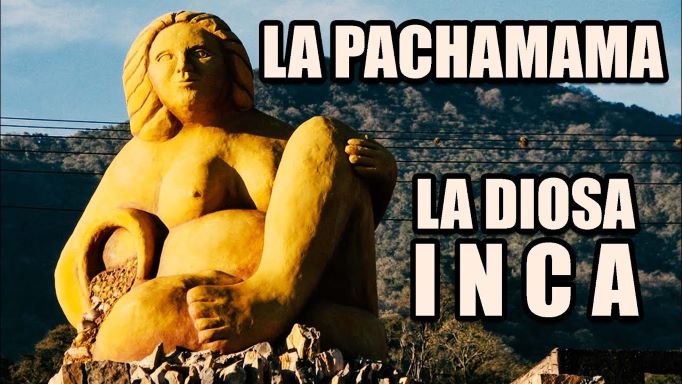Hello bloggers today we are going to talk, write about the Pachamama, Mother Earth, Andean culture in South America. Read in the blog below.
About the Pachamama:


Pacha Mama or Pachamama is the goddess worshiped by the indigenous peoples of the Andes, Peru, Bolivia and she is also known as Mother Earth/Time. In Inca mythology, Pachamama is a fertility goddess who presides over planting and harvesting, personifying mountains and causing earthquakes.
She is also an omnipresent and independent deity who has her own self-sufficient creative power to sustain life on Earth. Shrines to her are sacred stones or trunks of legendary trees, and her artistic depiction shows her as an adult woman carrying the potato and coca leaf harvest.
The 4 Quechua cosmological principles: water, earth, sun and moon, affirm that the Pachamama is its origin. The priests sacrifice flames, guinea pigs and elaborate miniature burnt clothes to her. After the Spanish conquest and conversion to Roman Catholicism, the figure of the Virgin Mary was united with that of Pachamama for many indigenous peoples.
In pre-Hispanic culture, Pachamama is often a cruel goddess eager for sacrifices. As Andean cultures shaped modern nations, Pachamama has remained benevolent, generous, and a local name for Mother Nature.
Therefore, many in South America like Peru and Bolivia believe that problems arise when people take too much from nature because they are taking too much from Pachamama. Pachamama is the mother of Inti, the sun god, and Mama Quilla, the moon goddess. It is also said that Pachamama is the wife of Inti, her son.
Etymology:
Pachamama is usually translated as Mother Earth, but a more literal translation would be “Mother World” (in Aymara and Quechua). The Inca goddess can be mentioned in many ways; the main one is Pachamama. Other names are Mama Pacha, Pachamama and Mother Earth. Pachamama differs from Pachamama in that “La” implies the intertwined connection the goddess has with nature, whereas Pachamama – without “La” – refers only to the goddess.
Worship of the goddess Pachamama:
The cult of Pachamama in the Andes predates the Incas, with her being relegated to a subordinate position to the Moon, the divine creator of women who ruled over all goddesses.
The Pachamama cult generally dealt with the daily earthly affairs of the local community. Likewise, the world of Huarochirí and the groups described in the idolatry documents mainly emphasized the deities of nature and the home and the sacred founders of their ancestral groups.
It is suggested that the abstract expressions of the Inca creative deity Viracocha would have mattered little to non-Inca communities far removed from the great calendar rituals in Cusco. The relationship between the Incas and the idols of the provinces is shown in the Huarochirí manuscript.
The presence of the Incas on the central coast contributed to the inclusion of the sun in the myths of Pachacámac and Con. During the colonial period, the cult of the main Inca deities did not continue, preferring Andean ones to meteorological and mountain deities. The cult of Pachamama also continued.
Why is Pachamama was so important to the Incas?
It’s because Pachamama is the one who protects the crops in the fields; the main production of the Incas. Her veneration is so great that in the vicinity of Cusco, in the Republic of Peru, there is an imposing Inca infrastructure called Moray, the main function was to carry out agricultural tests at different heights, currently the rites are performed in honour of Pacha Mama invoking her help in the plantations.
Celebrations for the goddess Pachamama in Peru:
As she is the goddess of nature, every August 1 her veneration of Pachamama in Peru is carried out in a very special way. Depending on the regions, for example, in Peru, Bolivia or Argentina, the rites may present some variations.
Traditionally the Incas feed and drink the mother earth, this rite is performed through a hole in the ground, once they place their offering and cover it, the community begins to dance around them, usually this rite is guided by the elders and in this way thank the goddess Pacha Mama.
Pachamama Raymi in Peru:
Pachamama Raymi in Peru, which means “Mother Earth Day” in Spanish, is celebrated every first week of August.
The people of Cusco pay homage to Mother Earth in gratitude for the blessings bestowed on their crops, which serve to sustain their families throughout the year. The tradition of worshiping the Pachamama in Peru dates back to pre-Hispanic times.
The Inca people considered her the protective deity of the Inca Empire, dedicated to nurturing and preserving the well-being of man. This celebration is an act of reciprocity and praise to nature, according to Andean cultures, to continue maintaining alliances with man.
The Incas had a lot of respect for the Apus (mountains) and Pachamama (Goddess of fertility), as well as the Sun God (Inti), being their main deities. Therefore, they performed ceremonies of worship to Mother Earth as a thank you for the harvests. The central date is August 1st, the day on which peasants do not work the land to let it rest, initiating the payment ritual.
About Dreamy Tours Agency:

Contact Us:
For more information, please contact us DREAMY TOURS, we will be happy to answer all your questions about Peru, Bolivia and Chile.
We are a Travel Agency specialized in tours, packages, if you need some information, please write to us.
We offer tours, excursions – Peru – Bolivia – Chile:










